
The Shaw Mansion is an Italianate style house in the George's Creek Valley of Allegany County, Maryland, built in 1872. The house is significant as an unusually large and well-preserved example of the style for its area, with stone trim, detailed brick bonding, cast-iron mantels and much of the original interior woodwork.
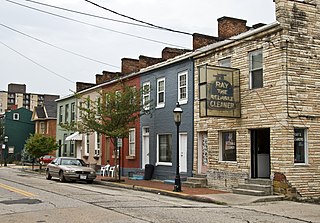
200, 202, 204, 206 and 208 Decatur Street are adjoining rowhouses in Cumberland, Allegany County, Maryland. The houses were built in the 1840s or early 1850s. The houses are of a type that, while common elsewhere in Maryland, were not extensively built in Cumberland, in which individual and semi-detached houses were more common. The houses exhibit plain but consistent detailing of a neoclassical nature.
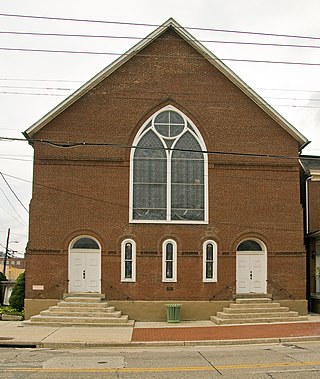
The African Methodist Episcopal Church in Cumberland, Allegany County, Maryland, was built in 1892 to replace a previous church which the congregation had outgrown. The congregation was founded in 1847 by a group of African-American Methodists who had previously worshiped from the balcony of the Centre Street Methodist Episcopal Church. The first church was built in 1848, then rebuilt and enlarged in 1871 and again in 1875.

Big Bottom Farm is a farm in Allegany County, Maryland, United States, on the National Register of Historic Places. The Greek Revival house was built circa 1845, possibly by John Jacob Smouse, and exhibits a level of historically accurate detailing unusual for the area. The property includes a late 19th-century barn and several frame outbuildings.
The Borden Mines Superintendent's House was built in 1850 in Frostburg, Allegany County, Maryland. The Italianate style villa was built for Albert C. Green, first superintendent of the Borden Mining Company, one of the oldest mining companies in the United States. The frame house, with its three-story tower was one of the first of this style to appear in Allegany County.
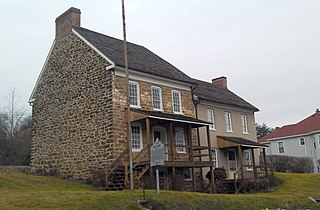
Michael Cresap House is a historic home in Oldtown, Allegany County, Maryland, USA. It is a 2+1⁄2-story, two-part stone and brick house built about 1764. The house is associated with Captain Michael Cresap (1742–1775), a well known Ohio frontiersman.

Thomas Koon House is a historic home in Cumberland, Allegany County, Maryland, United States. It is a brick Prairie-style house of large scale built in about 1912. It features arranged rectangular blocks with large expanses of window space, a terra cotta tiled hip roof and a small similarly influenced detached garage. The house was designed by Holmboe & Lafferty of Clarksburg for Doctor Thomas W. Koon, who arrived in Cumberland setting up an "active general practice" in May 1900.

George Truog House is a historic home in Cumberland, Allegany County, Maryland, United States. It is a 3-story brick structure built in 1903. The house was designed by local architect Wright Butler, and built by George Truog, proprietor of the Maryland Glass Etching Works in Cumberland from 1893 to 1911. It contains a unique collection of decorative glass.

Hocking House is a historic home in Frostburg, Allegany County, Maryland, United States. It is a 2+1⁄2-story, three-bay, hip-roofed dwelling, built about 1855 in the transitional Greek Revival-Italianate architecture style. The land on which the home stands was part of the estate of Robert Clarke Sr., one of the original settlers of the area that is now Frostburg. It was converted into a clubhouse in 1942.

Wright Butler House is a historic home in Cumberland, Allegany County, Maryland, United States. It is a 2+1⁄2-story, Queen Anne-style suburban one-unit dwelling built about 1896. The house was the home of Wright Butler (1868–1932), one of Cumberland's leading architects at the turn of the 20th century. He also designed the George Truog House.

Union Grove Schoolhouse is a historic one-room school building in Dickens, Allegany County, Maryland. It is a one-story frame building, rectangular in plan, containing a single classroom and an entrance vestibule. It is the last remaining one-room schoolhouse on its original site and in unaltered condition in Allegany County.
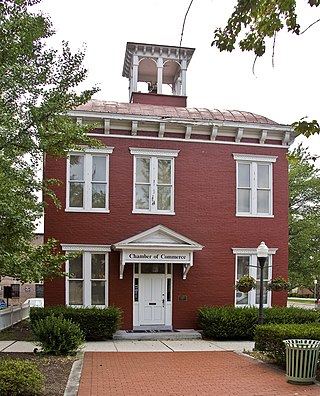
Bell Tower Building, or the Allegany County League for Crippled Children building, is a historic building in Cumberland, Allegany County, Maryland. It was built in 1887 and is a two-story brick structure topped by a small wooden tower with an open belfry. This was the first separate building to be used as police headquarters and jail in Cumberland.

First Baptist Church is a historic church in Cumberland, Allegany County, Maryland. It is a T-shaped gable-front brick structure of one and a half stories, with a white glazed brick facade that was added in 1917 to the existing church structure erected in 1849. The architecture is a modest interpretation of the late Gothic Revival style.
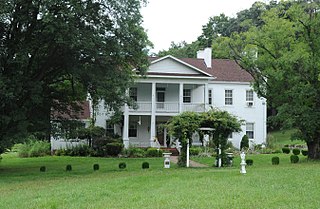
Phoenix Mill Farm, historically known as Mill Run Farm, is a historic home located in Dickens, Allegany County, Maryland, United States. It is a 2+1⁄2-story Flemish bond brick structure showing Greek Revival style influences built about 1845. It has a gable roof and double flush chimneys. On the property is the site of Smouse Mill. The home was erected for John Jacob Smouse, who operated the mill.
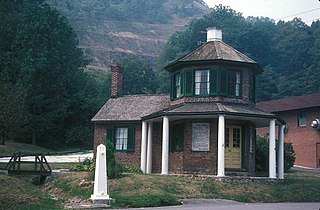
La Vale Tollgate House is a historic toll house in La Vale, Allegany County, Maryland, United States. It is a two-story brick structure built in 1835–1836, with seven sides—a basic polygon plan. A one-story Tuscan-columned porch extends around the five outer sides of the polygonal portion. On top is a non-functional reconstructed cupola. The building served as a toll house on the Cumberland or National Road and was the first such structure to be erected.

The Waverly Street Bridge, also called the Westernport Bowstring Arch Truss Bridge, was a historic steel bowstring truss bridge at Westernport, Allegany County, Maryland, United States. It carried vehicular traffic on Waverly Street over George's Creek. The bridge had a span length of 108 feet (33 m). It was built in 1892, by the King Bridge Company of Cleveland, Ohio.

Western Maryland Railroad Right-of-Way, Milepost 126 to Milepost 160 is a historic section of the Western Maryland Railway (WM) in Allegany County, Maryland, and Morgan County, West Virginia. It is an abandoned 34-mile (55 km) section of the right-of-way between milepost 126 at the intersection of the Chesapeake and Ohio (C&O) Canal and Long Ridge Road, Woodmont, and milepost 160 just west of Maryland Route 51, North Branch. It closely parallels the Potomac River and the C&O Canal, which runs along the north bank of the river, and includes three tunnels. Seven miles of the roadbed are in West Virginia near Paw Paw.
The Shawnee Old Fields Village Site, is an archaeological site near Oldtown in Allegany County, Maryland. The site contains Late Woodland and Contact period artifacts. An area between the site and the river's edge may be the location of a number of short-term camps and/or dwelling units. The first confirmed archeological manifestation of the several historically documented Shawnee villages in Maryland. It is believed to have been the home of Chief Opessa Straight Tail, a Shawnee leader.

The Washington Street Historic District is a national historic district named after George Washington in Cumberland, Allegany County, Maryland. It is an approximately 35-acre (140,000 m2) residential area to the west of downtown Cumberland and consists primarily of six blocks of Washington Street. It contains large-scale 19th- and 20th-century houses representing most of the major architectural styles, including examples of Greek Revival, Italianate, Gothic, Queen Anne, Romanesque, Colonial Revival, and bungalow. Also included in the district are the 1890s Romanesque courthouse, the 1850s Greek Revival academy building, and the Algonquin Hotel. It was listed on the National Register of Historic Places in 1973.

Klots Throwing Company Mill is a historic silk mill located at Cumberland in Allegany County, Maryland, United States. It was built in 1902–1903, and is a long two-story brick building with double-gable roofs and paired stepped parapets. An addition was built in 1909. It was operated by Gentex Corporation and closed in 1972. The building was subsequently used for storage. From 1988 until 2002, the north end of the building housed the Western Maryland Food Bank. The building will be converted to loft apartments.






















